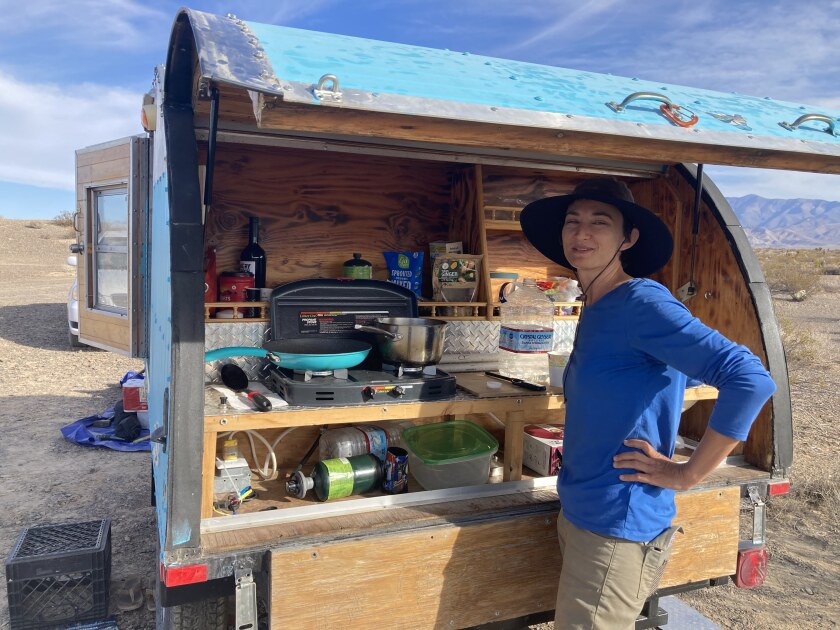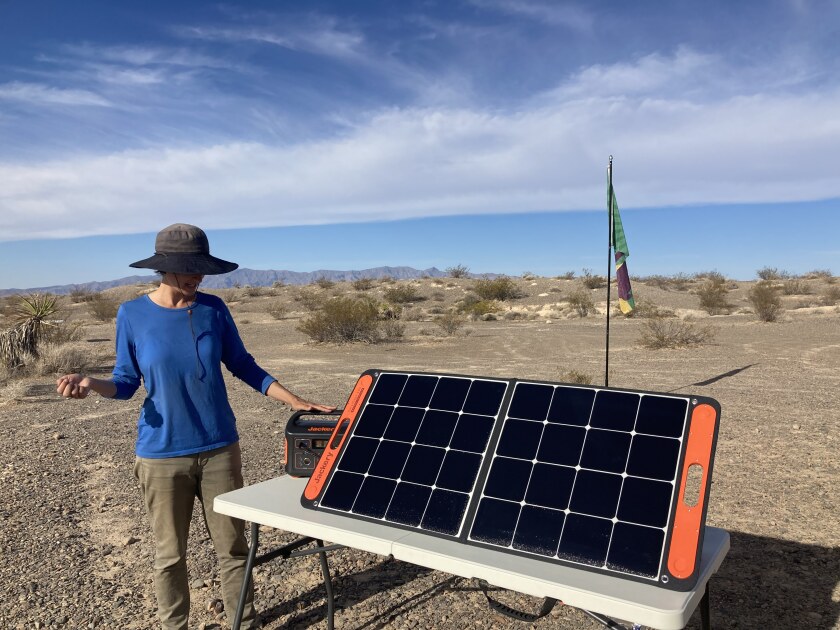Is this really green The fight over solar farms in the Mojave Desert
When some people look at the Mojave Desert, they see a vast expanse of nothing. But Shannon Salter sees ancient Mojave yuccas and wispy creosote bushes, shrewd kangaroo rats and slender foxes, all living atop a hard-packed crust of rock and lichen formed over thousands of years.
“There’s this idea that it’s a wasteland,†Salter said. “No, it’s a vibrant, amazing thing. We are turning it into a wasteland with all of our antics.â€
In mid-October, Salter, a 37-year-old poet and writing teacher, moved into a campsite in the Pahrump Valley â€" just east of the California border in southern Nevada â€" to protest a solar project that she and other activists argue will irreparably damage the fragile desert ecosystem.
 Shannon Salter, 37, camps in protest near the site of the Yellow Pine solar project in Nevada’s Pahrump Valley. She is living out of a wooden camper. (Meg Bernhard / For The Times)
Shannon Salter, 37, camps in protest near the site of the Yellow Pine solar project in Nevada’s Pahrump Valley. She is living out of a wooden camper. (Meg Bernhard / For The Times) Yellow Pine, a 3,000-acre solar farm, will provide 500 megawatts of electricity to 100,000 homes in California.
It’s the sort of renewable energy project that scientists and policymakers gathering this week in Glasgow, Scotland, for the United Nations climate conference, or COP26, say is needed on a massive scale to wean the world off fossil fuels and stave off the worst effects of global warming.
But even clean energy, from wind to solar to hydropower, isn’t entirely clean.
More than 100,000 yucca and other plants will be destroyed during construction of Yellow Pine. This year, scientists relocated more than 100 federally protected desert tortoises from the site in preparation for construction, but about 30 of those have died, possibly eaten by badgers.
“Is this really the way we want to do this?†Salter said. “Is this really green?â€
Other environmentalists believe more can be done to minimize the damage from solar farms, but accept some ill effects as the price of reducing carbon emissions.
“We try to be really pragmatic,†said Shayna Steingard, a policy analyst at Defenders of Wildlife, a national conservation group that works to protect native animals and plants. “We know that we have to meet our renewable energy goals and that is going to rely a lot on solar energy at the utility scale, that we will need to develop in the desert.â€
Solar developers have long viewed the Mojave as prime real estate because of its sparse population and abundant sunshine. Two-thirds of Nevada â€" including the Yellow Pine site â€" is public land overseen by the federal Bureau of Land Management, offering one-stop shopping for massive swaths of land.
Construction at the Yellow Pine site is expected to start in coming months and be completed by the end of next year. It is part of a new generation of facilities that feature not only photovoltaic solar panels but also lithium-ion battery storage that enables delivery of electricity at night.
The developer, NextEra Energy Resources, a renewable energy company based in Florida, says the project will create 350 jobs during construction and generate $46 million in tax revenue for Nevada’s Clark County over 30 years.
“The company is working closely with state and federal agencies and has taken significant steps in project siting and design to minimize the overall environmental impacts of the project,†Bryan Garner, a spokesperson for the company, wrote in a statement.
Plants will be mowed but not completely razed in hopes that they will eventually grow back.
Steven Grodsky, a scientist with the United States Geological Survey, said more research is needed to understand the effects of solar development on desert ecosystems.
“We’re in the midst of this rapid and necessary energy transition, but we don’t have a clear path forward in terms of how to do it sustainably,†he said.
In studies of the Ivanpah Solar Power Facility in Nipton, Calif., Grodsky and other federal researchers have found declines in biodiversity. Cacti and yucca never grew back, the population of moths and other non-bee pollinators fell, and thousands of birds die each year from collisions with solar panels or immolation inside the facility.
Instead of building in the desert, some conservationists advocate for what’s known as distributed solar â€" smaller solar panels built on top of roofs and parking lots in urban areas, places where wildlife has already been disturbed.
But many experts say that such a patchwork approach is impractical and insufficient given the threat of climate change. The Department of Energy recommends erecting solar panels in both cities and rural areas.
“They have generally concluded in order to meet the renewable energy requirements that the country has over the next 30 years we need to do both,†said Heidi Hartmann, an environmental scientist with the Argonne National Laboratory in Illinois who has worked with federal agencies to determine the best locations for solar farms.
Lawmakers across the nation have unveiled ambitious plans for renewable energy. In September, the Biden administration issued a plan that would see the country generating 45% of its electricity from solar panels by 2050.
The Nevada Legislature passed a bill in 2019 that requires the state to generate half its electricity from renewables by 2030 â€" nearly doubling their current share.
Nine solar installations are already operating on federal land in Nevada, with several others in the works, according to a Bureau of Land Management spokesperson. Over the summer, a plan for what would have been the largest solar farm in the state was scrapped after residents in the Moapa Valley protested that it would have been an eyesore that hurt tourism.
Salter is not opposed to the solar industry. She just doesn’t want it in the desert â€" a place she quickly came to love after moving from Irvine to Nevada about a decade ago.
Her first environmental protests were against hydraulic fracking. She has also fought a proposal to erect wind turbines near a forest of Joshua trees.
Now she spends each morning walking a mile or so from her campsite to the Yellow Pine construction zone.
“I just want to be able to see what’s going on all the time,†she said. “Every day I’m going over there. I’m getting to know the valley better.â€
A barbed-wire fence marks the boundary of the future solar field. On a recent morning, developers were testing the soil’s stability to determine where they’d begin drilling.
Salter walked toward a cluster of trucks and greeted two workers. “What are those?†she asked, pointing to a square hole in the fence with a slab of wood underneath.
“They’re for the birds,†replied a woman wearing a hard hat who was there to make sure the developers followed federal guidelines for protecting wildlife. “So they don’t get stuck to the fence.â€
Returning to her campsite, Salter ran into Ron Callison, a Pahrump resident whom she’d met the week before. He gave her cookies made of mesquite flour and said he would camp with her that night.
“Ninety-nine-point-nine percent of the country says, I’ve been across Nevada, there’s nothing out there,†Callison said. “Someone in Connecticut says, there’s just a lot of dried up bushes. They just happen to be hundreds of years old.â€
Salter nodded.
She understands that killing the Yellow Pine project is almost certainly a lost cause. There are still occasional protests, usually no more than a few dozen people. But it’s been a year since the Bureau of Land Management rejected a petition from the Nevada conservation group Basin and Range Watch to block construction.
 Shannon Salter sets up a 100-watt solar panel on a folding table to generate her own electricity for charging her laptop and cellphone for her online tutoring jobs.
Shannon Salter sets up a 100-watt solar panel on a folding table to generate her own electricity for charging her laptop and cellphone for her online tutoring jobs. (Meg Bernhard / For The Times)
Still, Salter said she plans to camp out as long as construction lasts, changing campsites every couple of weeks to stay in compliance with the rules about living on federal public land.
Her accommodations are sparse: a wooden camper hauled in by friends with a truck and outfitted with a mattress and a thick sleeping bag. To generate her own electricity â€" which she needs to charge her laptop and cellphone for her online tutoring jobs â€" she set up a 100-watt solar panel on a folding table.
To shower, she drives her Toyota 30 miles to Tecopa, Calif., where there are natural hot springs, and for meals she uses a propane stove.
In her view, leaving would mean giving up, and the issue is not going away.
In the Pahrump Valley, four other solar development projects, all within a day’s walk of Salter’s camp, are awaiting federal approval.
Bernhard is a special correspondent.
0 Response to "Is this really green The fight over solar farms in the Mojave Desert"
Post a Comment